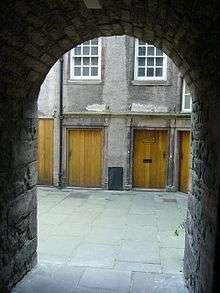John MacMorran

Baillie John MacMorran (d. 1595), merchant and Baillie of Edinburgh, killed during a riot at Edinburgh High School. His house at Riddle's Court is a valued monument on Edinburgh's Lawnmarket.
Career
John MacMorran was a merchant involved in shipping, with shares in nine ships worth over £4,000 at his death, and had exported one cargo of wax and salmon worth £3,928, large amounts at the time, indicating he was one of wealthiest merchants in Edinburgh.[1] MacMorran had been a servant of Regent Morton in the 1570s, and it was said that he helped conceal the former Regent's treasure. The townspeople also complained that he had exported grain to Spain (a Catholic country) in times of dearth.[2] He built a large house in Edinburgh's Lawnmarket, which still survives, now known as Riddle's Court.[3] A carved window frame with shutters from the MacMorran house is displayed at Edinburgh's Huntly House museum.[4]
Death at the Edinburgh High School

The scholars at Edinburgh High School were disputing the length of their holidays. They managed to shut themselves up in the building, at that time on the site of the old Blackfriars Monastery, near the present-day Drummond Street. After two days, on 15 September 1595, the town council sent John MacMorran, as a Baillie of Edinburgh, to end the sit-in. MacMorran and his men were about to break in, using a beam as a battering-ram, when he was shot in the head and died instantly. The shot was fired from a window by the 13-year-old son of William Sinclair of Mey, uncle and Chancellor of the Earl of Caithness.
The boys either fled or were captured. Justice was delayed for several months, as both the children' families and MacMorran's family were wealthy and able to ask the King, James VI of Scotland, to intervene. Lord Home made representations for one English culprit, the son of one Richard Foster, who was the first prisoner to be released. The English diplomat George Nicholson heard the town would benefit by raising contributions for building churches from the boys' supporters.[5] Seven were released soon after James Pringle of Whytbank (who lived at Moubray House), made a plea on their behalf to the Privy Council late in November.[6] Eventually young William Sinclair and all the others were released without penalty.[7]
House at Riddle's Court
John's house and contents, and his business, passed to his brother Ninian, to administer for John's children and his widow Katherine Hutcheson.[8] In March 1598 two banquets were held in the house for Ulrik, the younger brother of Anne of Denmark.[9]
Used in the 19th century by the educationalist and polymath Patrick Geddes, the house is now cared for by the Scottish Historic Buildings Trust (SHBT), and in part used by the Worker's Educational Association. The building is also home to the Architectural Heritage Society of Scotland.
References
- ↑ M. Sanderson, 'Edinburgh Merchants', in E. Cowan, ed., Renaissance & Reformation in Scotland, (Edinburgh, SAP, 1983), pp. 190-1
- ↑ R. Chambers, Domestic Annals of Scotland, vol. (1858), p. 144, 263: J. Melville, Memoirs of his own life, (Edinburgh 1827), p. 267
- ↑ RCAHMS Canmore, images of Riddle's Court
- ↑ pictured in R. Chambers. The Ancient Domestic Architecture of Edinburgh, (1859), p. 9
- ↑ Calendar State Papers Scotland, vol. 12 (1952), p. 19, 33
- ↑ D. Masson, ed., Register of the Privy Council of Scotland, vol. 5 (Edinburgh 1882), pp. 236-8.
- ↑ R. Chambers, Domestic Annals of Scotland, vol. (1858), pp.261-264
- ↑ J. MacPhail, ed., Fraser Papers, (Edinburgh, SHS, 1924), 227
- ↑ M. Wood, ed., Extracts Records ... Edinburgh, (Edinburgh 1927), pp. 218, 362-365: M. Pearce, 'Riddle’s Court,' in History Scotland Magazine, vol. 12 no.4 (July August 2012) pp. 20-27